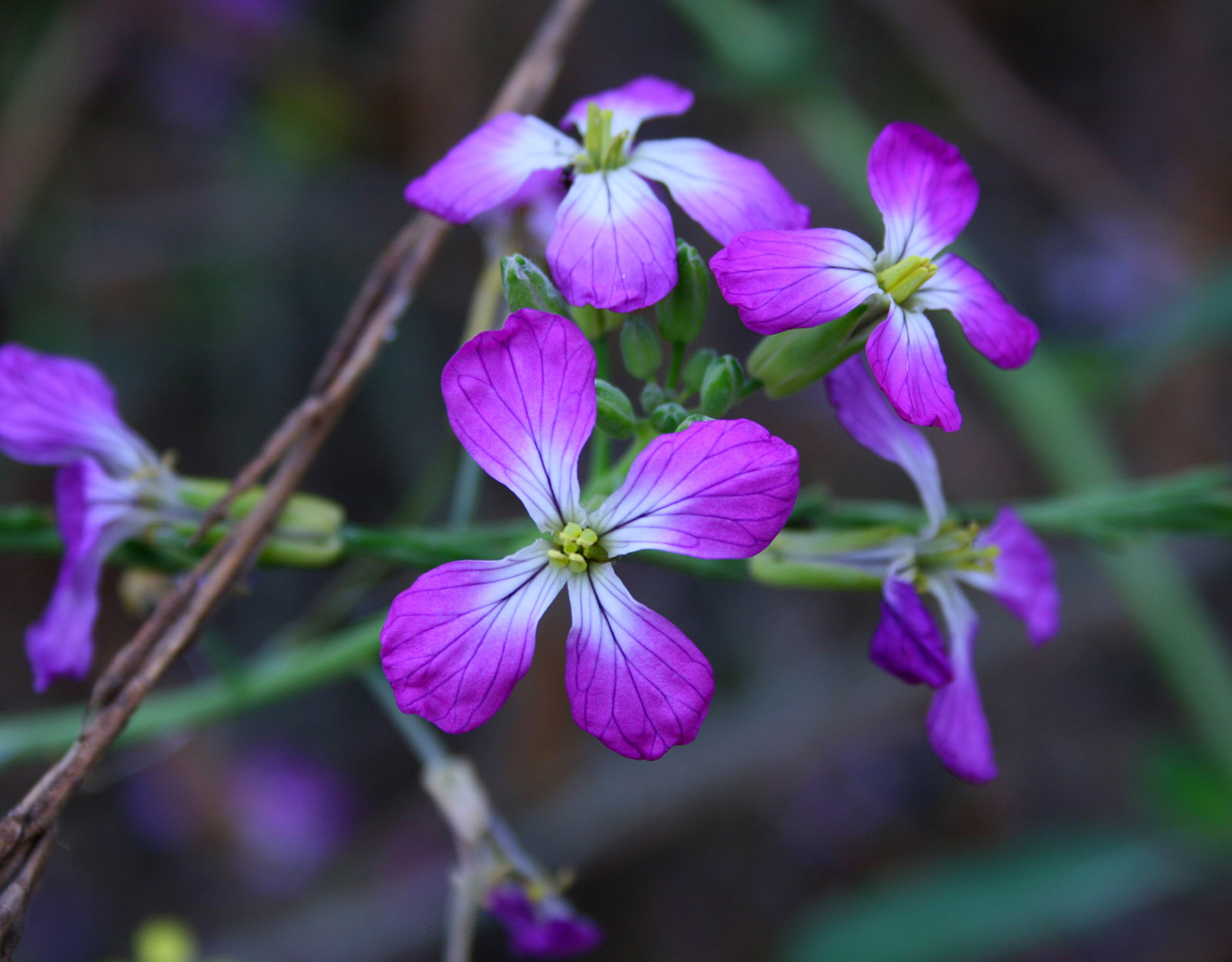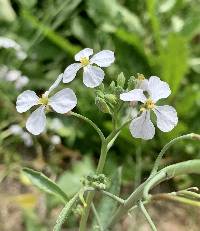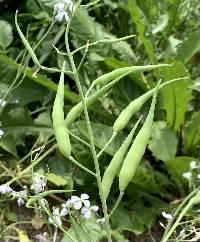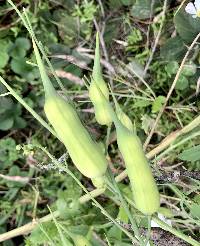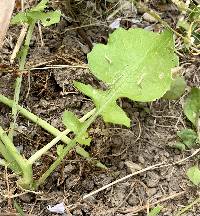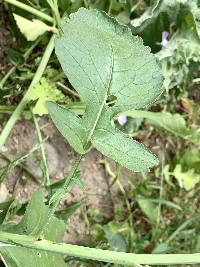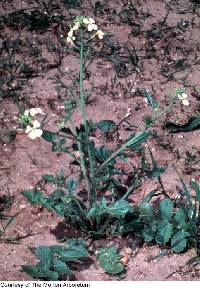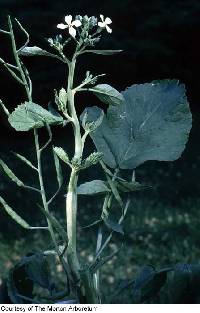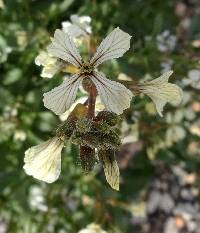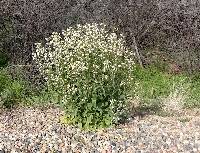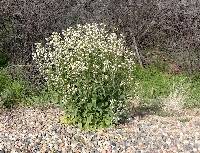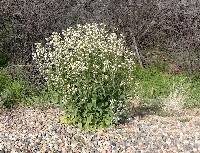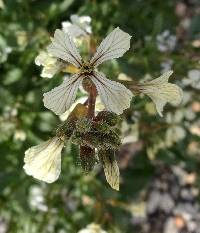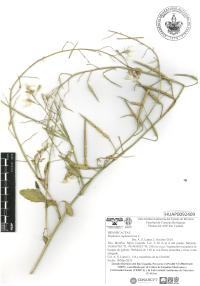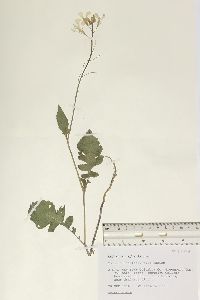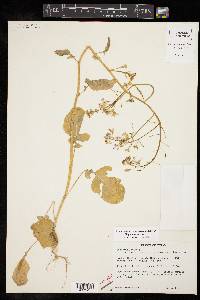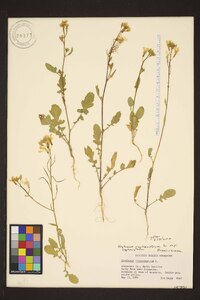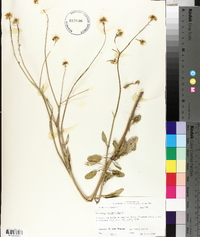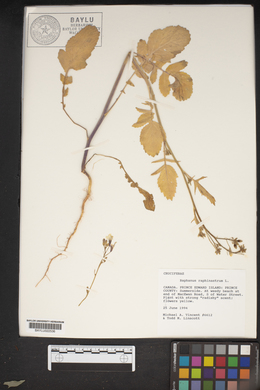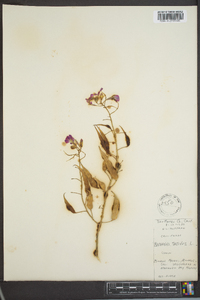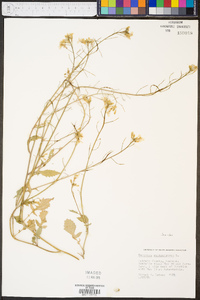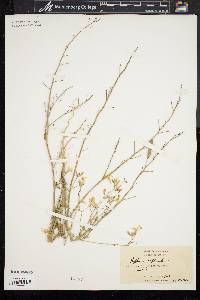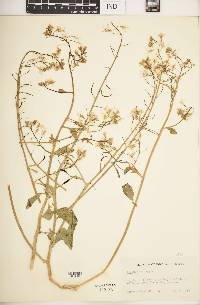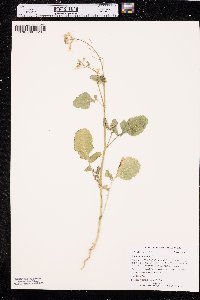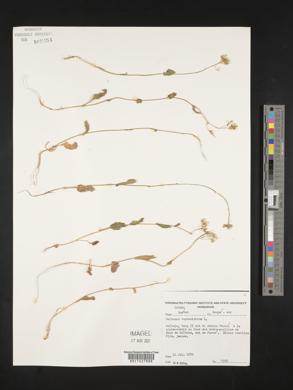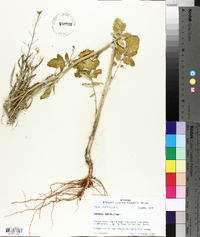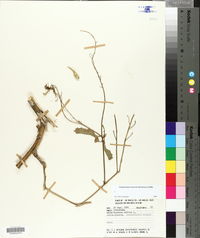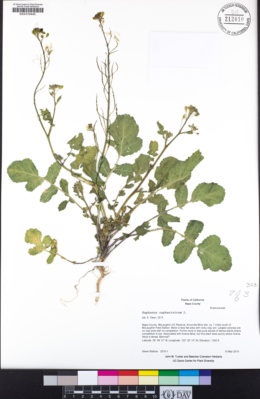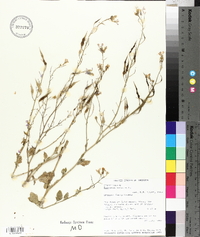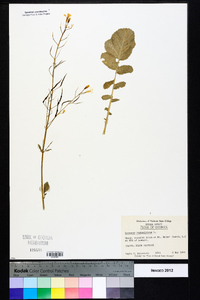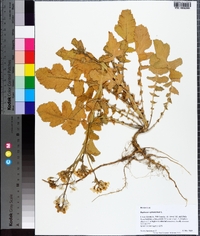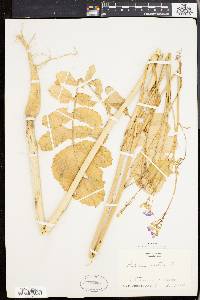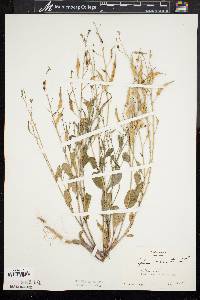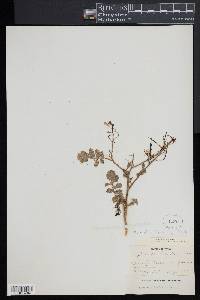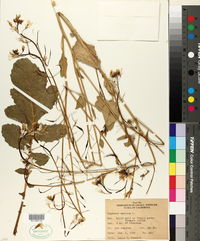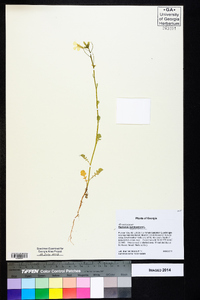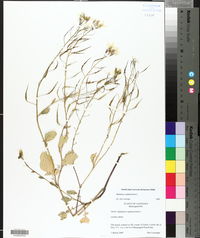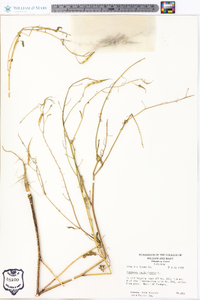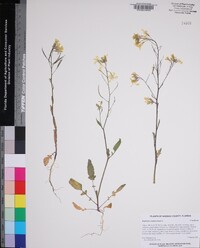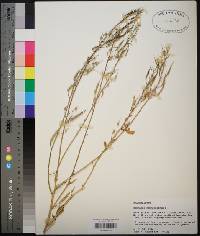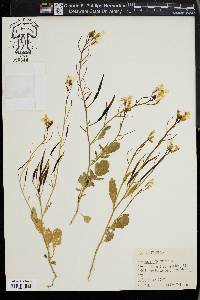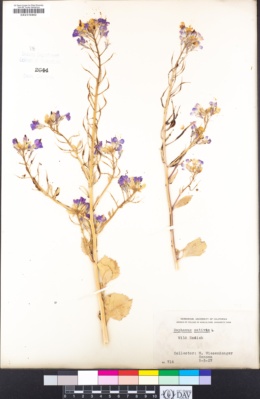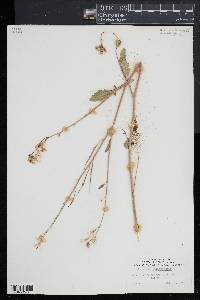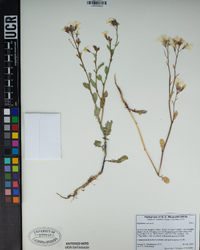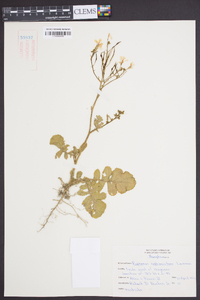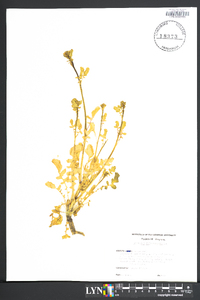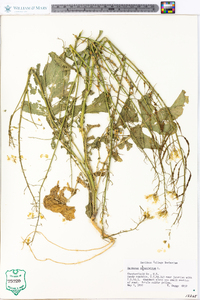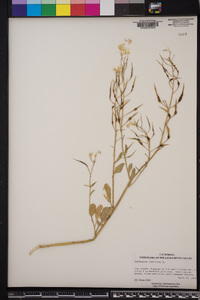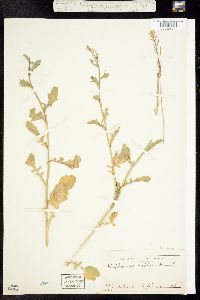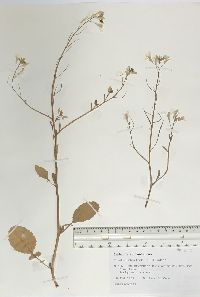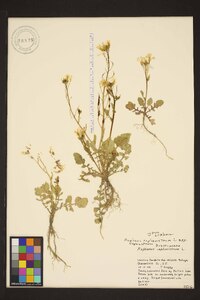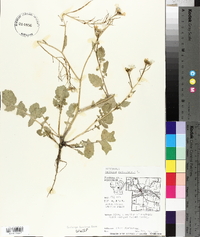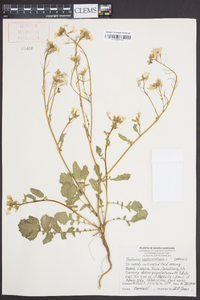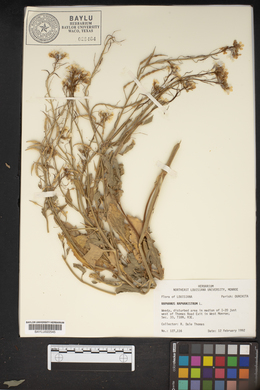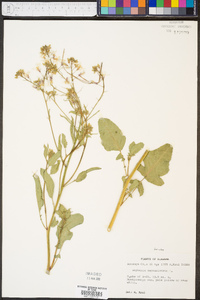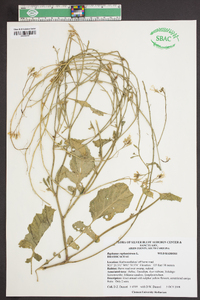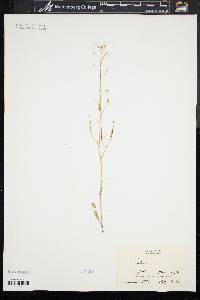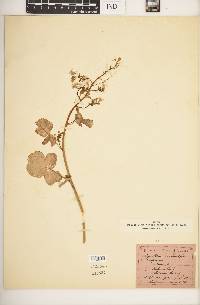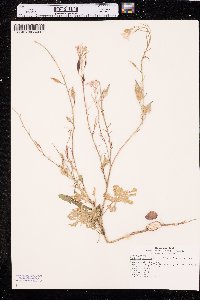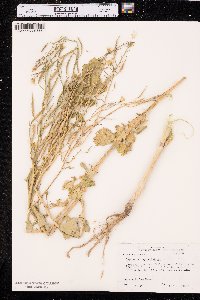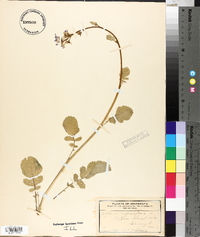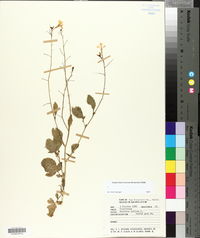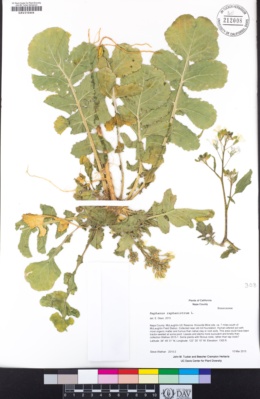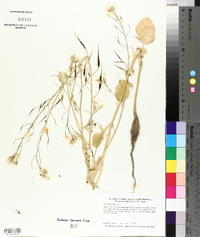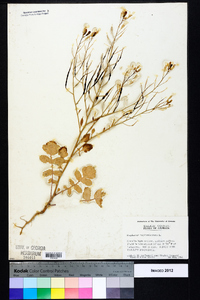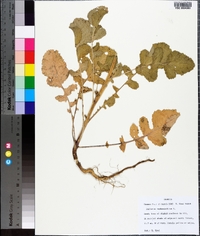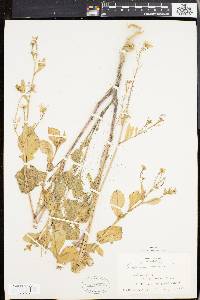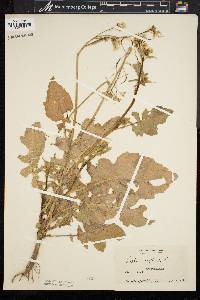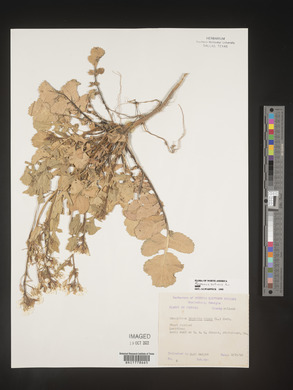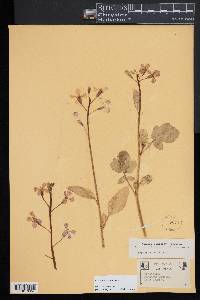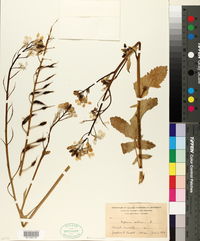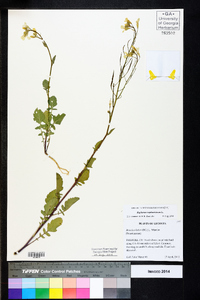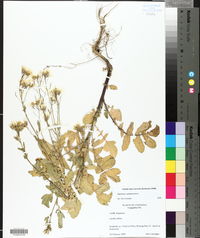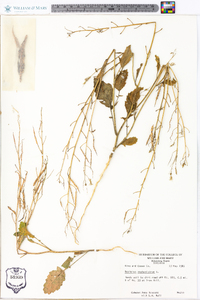Raphanus raphanistrum
|
|
|
|
Family: Brassicaceae
Wild Radish
|
Annuals, roots not fleshy; sparsely to densely pubescent. Stems usually simple from base, (2-)3-8 dm, (retrorsely hispid). Basal leaves: petiole 1-6 cm; blade oblong, obovate, or oblanceolate in outline, lyrate or pinnatifid, sometimes undivided, 3-15(-22) cm × 10-50 mm, margins dentate, apex obtuse or acute; lobes 1-4 each side, oblong or ovate, to 4 cm × 20 mm (smaller than terminal). Cauline leaves (distal) subsessile; blade often undivided. Fruiting pedicels divaricate or ascending, 7-25 mm, (straight). Flowers: sepals 7-11 × 1-2 mm, sparsely pubescent; petals yellow or creamy white (veins dark brown or purple), 15-25 × 4-7 mm, claw to 15 mm; filaments (slender), 7-12 mm; anthers 2-2.5 mm. Fruits cylindrical or narrowly lanceolate; valvular segment 1-1.5 mm; terminal segment (1.5-) 2-11(-14) cm × (2.5-)3-8(-11) mm, (base rounded), strongly constricted between seeds (usually breaking), strongly ribbed, beak narrowly conical; style 10-50 mm. Seeds (reddish brown or dark brown to black), oblong or ovoid, 2.5-3.5 × 1.8-2.5 mm. 2n = 18. Flowering May-Jul. Disturbed waste places, cultivated fields, roadsides, orchards, hill slopes; 0-800 m; introduced; Greenland; St. Pierre and Miquelon; Alta., B.C., Man., N.B., Nfld. and Labr., N.S., Ont., P.E.I., Que., Sask.; Ala., Alaska, Ariz., Ark., Calif., Colo., Conn., Del., D.C., Fla., Ga., Idaho, Ill., Ind., Iowa, Kans., Ky., La., Maine, Md., Mass., Mich., Minn., Miss., Mo., Mont., Nebr., Nev., N.H., N.J., N.Mex., N.Y., N.C., N.Dak., Ohio, Okla., Oreg., Pa., R.I., S.C., S.Dak., Tenn., Tex., Utah, Vt., Va., Wash., W.Va., Wis., Wyo.; Europe; Asia; introduced also in Mexico, Central America, South America, Africa, Atlantic Islands, Australia. North American representatives of Raphanus raphanistrum are referable to subsp. raphanistrum. Four other subspecies are restricted to Europe.
Annual herb with a thick taproot 30 cm - 0.8 m tall Stem: sparsely hairy. Flowers: in branched clusters (raceme). Sepals four, upright, tips rounded. Petals four, yellow, becoming white, 1 - 1.5 cm long, bases narrowed. Fruit: a long, narrow pod, 2 - 4 cm long, separated into two distinct parts. The upper part (beak) is 1 - 3 cm long. When fresh, the fruit is nearly cylindrical. When dry it is prominently ribbed and constricted between the seeds. Seeds in one row. Lower leaves: pinnately divided into five to fifteen oblong segments, 10 - 20 cm long, oblong, sparsely hairy. The lower segments are very small, while the upper ones get progressively larger. Upper leaves: alternate, often reduced. Similar species: Raphanus sativus is similar but has pink flowers and a thicker taproot. Flowering: mid-May to early September Habitat and ecology: Introduced from Eurasia. Local in waste ground, especially in areas with nutrient-rich soil. Occurence in the Chicago region: non-native Etymology: Raphanus means "quickly appears." Raphanistrum comes from the Greek word raphanis (quickly appears), which is the ancient name for this vegetable. Author: The Morton Arboretum Jepson, FNA 2010, Morton Arboretum, Allred and Ivey 2012 Duration: Annual/Biennial Nativity: Non-Native Lifeform: Forb/Herb General: Annual to biennial herb, 20-80 cm tall, from a taproot; stems usually 1 per plant, erect, branching above; herbage sparsely to densely hairy with retrorse hairs. Leaves: Basal and lower stem leaves petioled, the blades 10-20 cm long, pinnately lobed to pinnately compound, the terminal lobe or leaflet widely ovate to round; upper stem leaves short-petioled to sessile, more or less dentate or few-lobed, and reduced in size. Stem leaves alternate. Flowers: Yellow to cream-colored, in terminal racemes; pedicels ascending, 10-25 mm long; sepals 4, erect, 7-11 mm long, the inner pair sac-like at base; petals 4, yellow or creamy white with dark brown or purple veins, 15-20 mm long. Fruits: Capsules 4-8 cm long, narrowly lanceolate and strongly constricted between the seeds, with a long-pointed tip; seeds oblong to ovoid, 3 mm wide. Ecology: Found in disturbed areas, fields, roadsides; below 8,000 ft (2438 m); flowers Apr-Sept. Distribution: Native to Eurasia and Africa; introduced to North and South America and Australia. Now present in most of the lower 48 states and the southern Canadian provinces. There are very few collections of this species from the Southwestern US, and most of those a Notes: This close relative of the cultivated radish (Raphanus sativus) is edible, though it lacks the fleshy root of the cultivated varieties. In California it hybridizes with Raphanus sativus to produce swarms highly variable in flower color and fruit constriction. It is primarily an agricultural weed in North America, though it has also invaded the natural landscape in some parts of Australia. Ethnobotany: Leaves, flowers, and seed pods are edible and used by modern Americans who practice wildcrafting. Documented as a folk medicine in Europe, and probably eaten there as well, historically. Etymology: Both the genus name and the specific epithet from Raphanis, Greek for appearing quickly, referring to the rapidity of the plants' growth. Synonyms: Crucifera raphanistrum, Rapistrum raphanistrum, Raphanistrum raphanistrum, Sinapis raphanistrum Editor: AHazelton 2015, AHazelton 2017 Coarse annual from a stout taproot, 3-8 dm, usually sparsely hispid; lower lvs obovate-oblong, 1-2 dm, pinnatifid into 5-15 oblong segments, the lower segments very small, the upper progressively larger; upper lvs reduced and often entire; pet yellow, turning white, 10-15 mm; mature pedicels ascending, 8-15 mm; fr nearly cylindric when fresh, when dry becoming prominently several-ribbed and constricted between the 4-10 seeds, the body 2-4 cm, the beak 1-3 cm, the lower member 1-2 mm, its upper margin indicated by a line or projecting rim extending half way to all around the fr; 2n=18. Native of Eurasia, established as a weed in fields and waste places and along roadsides throughout most of the U.S. and s. Can. June-Aug. Gleason, Henry A. & Cronquist, Arthur J. 1991. Manual of vascular plants of northeastern United States and adjacent Canada. lxxv + 910 pp. ©The New York Botanical Garden. All rights reserved. Used by permission. From Flora of Indiana (1940) by Charles C. Deam J. M. Coulter wrote of this species (Bot. Gaz. 1: 34. 1876) that in Jefferson County it "has been found taking possession of some of our fields." Welch reports it from Jasper County. Peattie says: "A bad European weed in old fields of the Calumet District," Lake County. I have never seen it or else I did not recognize it. …… Indiana Coefficient of Conservatism: C = null, non-native Wetland Indicator Status: N/A |
|
|
|

